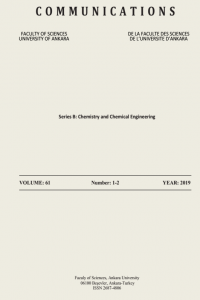THE INFLUENCE OF Pseudomonas aeruginosa ON CORROSION BEHAVIOR OF NICKEL-COBALT ALLOY
Bu çalışmanın amacı, Pseudomonas aeruginosa bakterisinin nikel-kobalt Ni-Co alaşımına korozyon etkisinin incelenmesidir. Korozyon oranı, Tafel ve elektrokimyasal empedans spektroskopisi EIS ile belirlenmiştir. Alaşım yüzeyinin morfolojisi ve bileşimi taramalı elektron mikroskobu SEM ve X-ışınları saçılımı EDS ile incelenmiştir. Tafel grafikleri, zamana bağlı olarak polarizasyon direncinin düştüğünü, akım yoğunluğunun ise arttığını göstermiştir. Bu değişim yüzeyde oluşan biyofilm tabakası ve çukurcuk korozyonu nedeniyledir. Nyquist yarım darireleri düşük frekanslarda açık hale gelmektedir. Korozyonun artığını gösteren bu değişim, alaşım yüzeyinde meydana gelen yarılma ve biyofilm tabakasında oluşan çatlaklardan dolayıdır.
THE INFLUENCE OF Pseudomonas aeruginosa ON CORROSION BEHAVIOR OF NICKEL-COBALT ALLOY
The aim of this study was to determine the effect of Pseudomonas aeruginosa bacterium on the corrosion of nickel-cobalt Ni-Co alloy. The corrosion rate was determined with using of Tafel slopes and Electrochemical Impedance Spectroscopy EIS . The morphology and the formation of the alloy surface were observed by scanning electron microscopy SEM and energy dispersive X-ray spectra EDS analysis. It was observed from the Tafel plots that the polarization resistance decreases and the current density increases with a change in time. This was attributed accumulation to the biofilm on the surface and therefore surface became pitted. The Nyquist semicircles tended to open at lower frequencies which indicated the crevice of the surface and the rupture of protective film
Keywords:
Microbial Corrosion, Nickel-Cobalt Alloy SEM, EIS,
___
- [1] Srivastava, M., Selvi, E., Grips, V.K.W., Rajam, K.S., 2006. Corrosion resistance and microstructure of electrodeposited nickel–cobalt alloy coatings, Surf. Coat. Technol., 201: 3051–3060.
- [2] Chang, L.M., An, M.Z., Shi, S.Y., 2005. Corrosion behavior of electrodeposited Ni-Co alloy coatings under the presence of NaCl deposit at 800 ºC, Mater. Chem. Phys., 94: 125-130.
- [3] Shi, L., Sun, C.F,. Zhou, F., Liu, W.M., 2002. Electrodeposited nickel–cobalt composite coating containing nano-sized Si3N4, Mater. Sci. Eng. A., 397: 190–194.
- [4] Melidis, P., Sanozidou, M., Mandusa, A., Ouzounis, K., 2007. Corrosion control by using indirect methods, Desalin., 213: 152–158.
- [5] Ornek, D., Wood, T. K,. Hsu, C.H., Mansfeld, F.,2002. Corrosion control using regenerative biofilms (CCURB) on brass in different media, Corros. Sci., 44: 2291–2302 .
- [6] Alvarez, R.B.,Martin, H.J., Horstemeyer, M.F., Chandler, M.Q., Williams, N., Wang, P.T., Ruiz, A., 2010. Corrosion relationships as a function of time and surface roughness on a structural AE44 magnesium alloy, Corros. Sci., 52: 1635–1648.
- [7] H.C. Fleming, E. Heitz, H.C. Fleming, K. Sand, Microbially Influenced Corrosion of Materials, Spring-Verlag, New York, 1996, p. 5. 6–14.
- [8] Duan, J.,Wu, S.,Zhang, X.,Huang, G.,Du, M., Hou, B., 2008. Corrosion of carbon steel influenced by anaerobic biofilm in natural seawater, Electrochim. Acta., 54: 22–28.
- [9] Messano, L.V.R., Sathler , L., Reznik, L.Y., Coutinho, R., 2009. The effect of biofouling on localized corrosion of the stainless steels N08904 and UNS S32760,Int.Biodeter Biodegr., 63: 607–614.
- [10] Melchers, R.E., 2002. Effect of temperature on the marine immersion corrosion of carbon steels, Corros. Sci., 58: 768–782.
- [11] Pope, D.H., Morris, E.A., 1995. Some experiences with microbiologically influenced corrosion of pipelines, Mater. Perform., 34: 23–28.
- [12] Heakal, F.E.T., Hefny, M.M., Tawab, A.M.A.E., 2010. Electrochemical behavior of 304L stainless steel in high saline and sulphate solutions containing alga Dunaliella Salina and β-carotene, J. Alloys. Compd., 491: 636–642.
- [13] Starosvetsky, J., Starosvetsky, D., Pokroy, B., Hilel, T., Armon, R., 2008. Electrochemical behaviour of stainless steels in media containing iron-oxidizing bacteria (IOB) by corrosion process modeling, Corros. Sci., 50: 540–547.
- [14] S.J. Yuan , S.O. Pehkonen., 2007. Microbiologically influenced corrosion of 304 stainless steel by aerobic Pseudomonas NCIMB 2021 bacteria: AFM and XPS study, Corros. Sci., 50: 540–547.
- [15] Abdelouas, A.,Lu, Y., Lutze, W., Nuttal, H.E.,1998. Reduction of U(VI) to U(IV) by indigenous bacteria in contamined ground water, J. Contam. Hydrol., 35: 217–233.
- [16] C.H. Hsu, F. Mansfeld., 2002. Corrosion control using regenerative biofilms (CCURB) on brass in different media, Corros.Sci., 44: 2291–2302.
- [17] K.Y. Chan, L.C. Xu, H.H.P. Fang, Anaerobic electrochemical corrosion of mild steel in the presence of extracellular polymeric substances produced by a culture enriched in sulfate-reducing bacteria, Enviren. Sci. Technol. 36 (2002) 1720-1727.
- [18] Cetin, D, Aksu, M.L., 2009. Corrosion behavior of low-alloy steel in the presence of Desulfotomaculum sp., Corros. Sci., 51:1584-1588.
- [19] Hassen, A., Saidi, N., Cherif, M., Boudabous, A., 1998. Effects of heavy metals on Pseudomonas aeruginosa and Bacillus thuringiensis, Bioresour.Technol.,65: 73–82.
- [20] Falih, A. M., 1997. Comparative toxicity of heavy metals to some yeast isolated from Saudi Arabian soil, Bioresour. Technol., 64: 193-198.
- ISSN: 1303-6017
- Başlangıç: 1948
- Yayıncı: Ankara Üniversitesi
Sayıdaki Diğer Makaleler
THE INFLUENCE OF Pseudomonas aeruginosa ON CORROSION BEHAVIOR OF NICKEL-COBALT ALLOY
